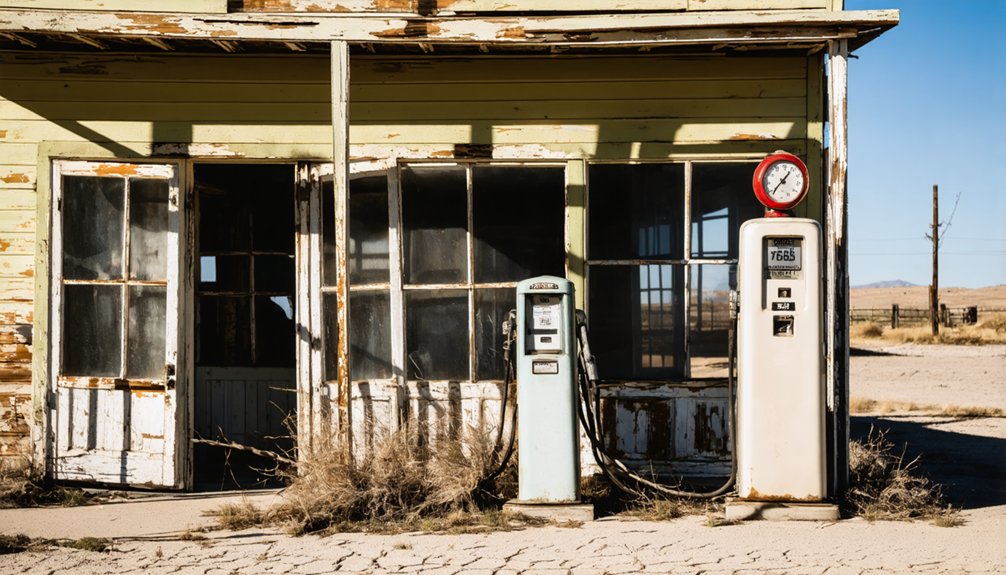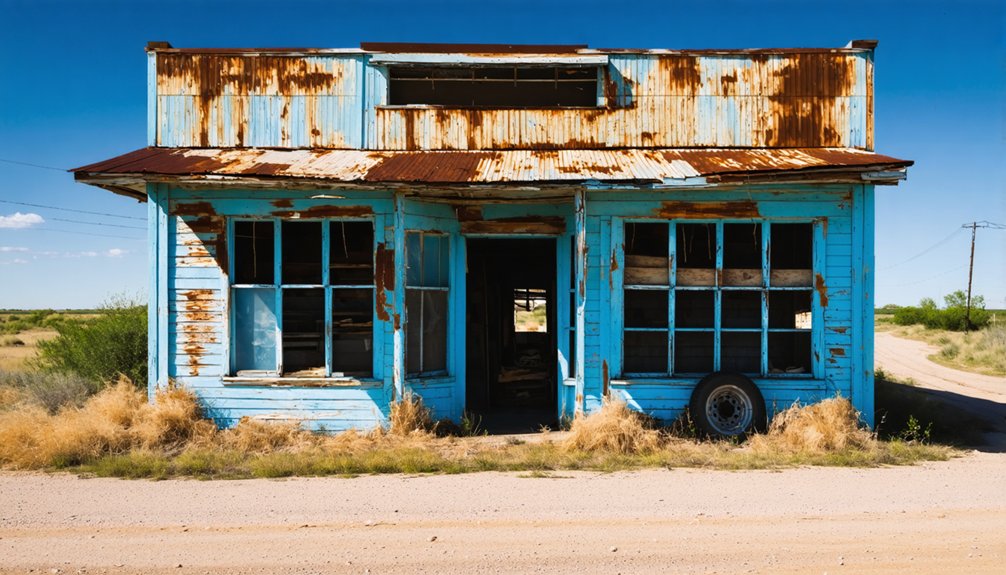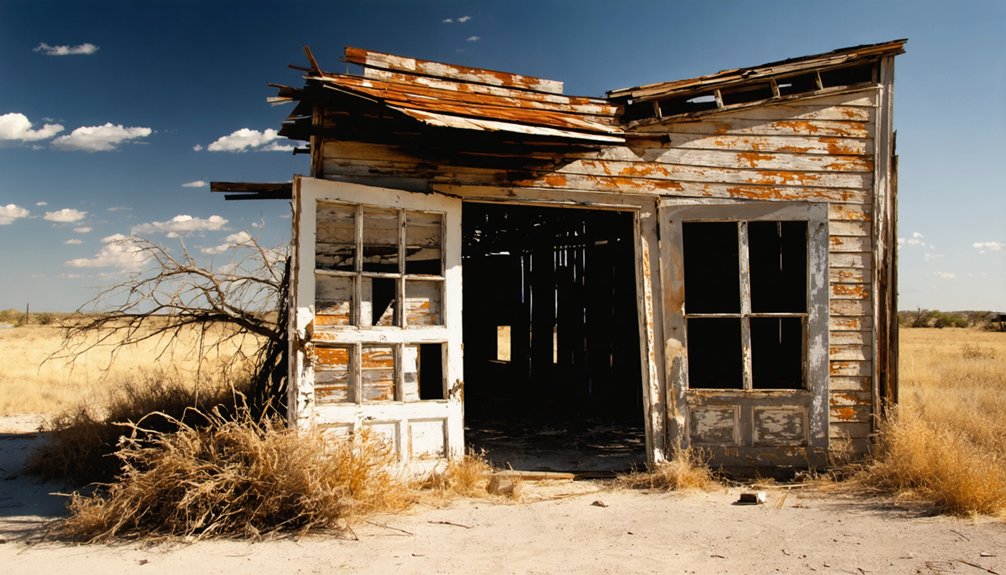You’ll find New Lynn’s ghost town remnants in Lynn County, Texas, where a 1930s farming settlement once thrived with 60 residents. The community centered around cotton production and tenant farming along the Chicago, Rock Island and Gulf Railway. By 1970, the population dwindled to just 15 people due to agricultural challenges and rural migration. Today, only scattered foundations mark where this tight-knit community persevered through droughts, economic hardships, and changing times. The site’s untold stories lie buried beneath pastureland.
Key Takeaways
- New Lynn was a 1930s settlement in Lynn County, Texas that declined to ghost town status by 1970 with only 15 residents remaining.
- The community relied heavily on cotton farming but faced economic challenges from droughts, falling prices, and the 1980s agricultural depression.
- Population peaked at 60 residents in the 1940s-1950s before declining due to youth migration and diminishing economic opportunities.
- No intact buildings remain today, with only scattered foundations and rubble marking the former community’s location.
- The site is now largely private pastureland, requiring permission to access, and holds archaeological significance for studying early Texas settlements.
Early Settlement and Origins
While many Texas communities trace their roots to the 19th century, New Lynn emerged later as a 1930s settlement in Lynn County, an area originally carved from Bexar Territory in 1876.
You’ll find this community’s origins intertwined with the region’s agricultural development, as settlers sought opportunities in the fertile West Texas plains.
The county’s namesake, G. W. Lynn, connects the area to Texas’ revolutionary heritage through his association with the Alamo.
As settlement patterns evolved in this semi-arid landscape, New Lynn took shape as a rural outpost, reflecting the broader colonization of Texas’ frontier regions.
The community’s establishment during the 1930s aligned with regional development trends, though it remained modest in size, characterized by scattered farmsteads and ranches typical of West Texas settlements.
Like many of the 511 ghost towns documented across Texas, New Lynn eventually succumbed to changing economic conditions and population shifts.
Similar to the story of Plemons, New Lynn’s prosperity depended heavily on its accessibility to travelers, though it never achieved the same prominence as a river crossing point.
The First School District
As settlers established roots in Lynn County, the formation of New Lynn’s school district marked a key development in the region’s educational landscape.
You’ll find it remarkable that the school district’s establishment predated the community itself, which wouldn’t emerge until the 1930s. This pioneering educational milestone reflected the area’s commitment to learning, even as the rural setting posed unique challenges.
While nearby communities like Lynn and T-Bar established their schools in 1902, New Lynn’s distinction as the county’s first school district showcased the determination of early settlers. Like the early Nederland schools, they prioritized English instruction to ensure student success.
New Lynn’s pioneering school district reflected the resilient spirit of early settlers, setting an educational precedent for Lynn County.
The cotton and ginning operations later became vital economic drivers that helped sustain the school district’s growth.
The district’s formation required substantial community involvement and careful resource management. Despite the slow population growth and limited funding typical of rural areas, this educational foundation would influence the development of other districts throughout Lynn County after its organization in 1903.
Community Life in the 1930s
Despite New Lynn’s modest beginnings in the 1930s, the community established itself with a population of roughly 60 residents by 1940.
You’d find a tight-knit farming society where community resilience and informal social networks helped residents weather challenging times. Similar to Thurber’s company store system, residents had to carefully manage their limited resources. The agricultural downturn hit the area hard, affecting both landowners and tenant farmers who worked more than half the county’s farms. Much like the nearby town of Terlingua, the community faced difficult economic conditions during the Great Depression era.
Life in New Lynn during the 1930s centered around these key aspects:
- Tenant farming dominated employment, with farmers working 1,448 of 2,138 local farms.
- Most families lived in scattered farmhouses rather than a concentrated town center.
- Social life revolved around agricultural cycles and family connections.
- Economic hardships, including drought and falling cotton prices, shaped daily existence.
Agricultural Heritage
The agricultural foundation of New Lynn tells a story beyond its community gatherings and social networks. You’ll find its cotton heritage deeply woven into the landscape, where farmers once worked 150-acre plots along the Chicago, Rock Island and Gulf Railway line.
Their agricultural practices centered on cotton production, with scattered farmsteads maximizing the region’s arable land. Four-mule teams worked the fields throughout the 1920s, showcasing the traditional farming methods of the era. You can still trace this legacy through the ruins of cotton gins and farmsteads that dot the countryside.
These farmers faced the harsh realities of West Texas – droughts, pests, and depleted soil tested their resilience. When the 1980s agricultural depression hit, New Lynn’s dependence on cotton proved fatal.
The town’s decline mirrors countless other farming communities that couldn’t survive the boom-and-bust cycle of single-crop dependence. Today, the Texas State Historical Association works to preserve these stories of agricultural communities that shaped the region’s development.
Population Patterns and Demographics
You’ll find that New Lynn maintained a remarkably steady population of sixty residents throughout the 1940s and 1950s, offering a snapshot of mid-century rural stability.
The town’s consistent population suggests it supported enough economic activity and essential services to sustain this modest community size. Like many other rural Texas communities, the town faced ongoing challenges in retaining residents as younger generations moved away seeking broader opportunities.
This population level was typical for small farming settlements in rural Texas during this period, where towns often clustered around agricultural centers and local mercantile establishments. The discovery of oil in 1950 brought new economic opportunities to the region, though it did not significantly alter New Lynn’s population.
Population Stability During 1940s
During New Lynn’s most stable demographic period, census records show the town maintained a consistent population of 60 residents throughout the 1940s and into the early 1960s.
This demographic stability reflected the town’s deep ties to the agricultural economy of Lynn County, where cotton farming had become the dominant industry.
You’ll find these key factors shaped New Lynn’s population during this period:
- The community’s tight-knit structure preserved existing family units
- Limited migration into or out of the area kept numbers steady
- Agricultural jobs provided enough stability to maintain the population
- Regional farming shifts helped prevent immediate decline
This stability wouldn’t last forever, though.
After 1960, you’d see the population plummet to just 15 residents by 1970, marking the beginning of New Lynn’s transformation into a ghost town.
Rural Settlement Size Analysis
Analyzing New Lynn’s settlement patterns reveals a classic example of mid-20th century rural Texas demographics.
You’ll find that during its peak years, the town maintained a small but stable population of about 60 residents, reflecting the rural isolation typical of West Texas communities. The settlement’s layout featured scattered homesteads and minimal clustering, characteristic of agricultural communities of that era.
As economic stagnation set in, you’d notice the town’s dramatic transformation from a functioning rural community to near abandonment.
The Quiet Decline
You’ll find New Lynn’s quiet decline followed a pattern common to many rural Texas communities, as residents gradually left for larger cities offering better economic prospects.
The town’s population dwindled through the mid-20th century, reflecting broader shifts that saw families moving away from agricultural areas toward urban centers with more diverse job opportunities.
Like many of its neighboring communities, New Lynn experienced this rural exodus primarily through the departure of younger generations, leaving behind an aging population that couldn’t sustain the town’s remaining services and infrastructure.
Rural Exodus Impact
While many Texas towns faced gradual changes over time, New Lynn’s quiet decline exemplifies the devastating impact of rural exodus on small communities.
You’ll find the town’s story reflected in the harsh realities of rural isolation and economic vulnerability that plague similar communities across the state.
The exodus transformed New Lynn through:
- A dramatic aging of the population as young families left, pushing the median age well into the 40s
- Plummeting property values, with homes often selling below $50,000
- Closure of essential services like post offices and local shops, cutting off crucial community lifelines
- A shrinking tax base that’s crippled the town’s ability to maintain infrastructure or attract new businesses
Population Shifts Over Time
Throughout the mid-20th century, New Lynn experienced a dramatic population transformation that turned a small but stable community into a ghost town.
You’ll find that the town’s population trends remained steady at about 60 residents from 1940 to 1960, but then plummeted to just 15 people by 1970.
Unlike other Texas ghost towns that vanished due to natural disasters or man-made projects, New Lynn’s demographic shifts occurred through a quiet, gradual decline.
The town’s remote location and lack of economic drivers contributed to its dwindling numbers.
This pattern mirrored broader rural depopulation trends in Lynn County, where limited employment opportunities and minimal infrastructure development failed to sustain the community’s viability.
Historical Significance in Lynn County

As Native American tribes shaped the early history of Lynn County, the region underwent significant changes from Plains Apache territory to Comanche dominance before opening to non-native settlement in 1877.
You’ll find the county’s historical significance reflected in these pivotal developments:
- Military skirmishes near Double Lakes and Tahoka Lake marked the shift from Comanche influence to U.S. settlement patterns.
- Early ranching focus established the county’s economic foundation, with population counts showing just 24 residents by 1890.
- Educational development began in 1902 with schools at Lynn and T-Bar, signaling community dynamics shifting toward permanent settlement.
- Economic shifts from open-range cattle to mixed farming transformed the region, leading to ghost towns like New Lynn when agricultural patterns changed.
The county’s evolution from Native American territory to organized settlement tells a story of freedom and adaptation in the Texas frontier.
Modern-Day Remnants
Today’s New Lynn bears little resemblance to its former self, with only scattered foundations and rubble marking where this once-thriving farming community stood.
You’ll find no intact buildings here – the ghost town remnants have succumbed to decades of weather and neglect, leaving behind mere footprints of its past existence. The land has largely reverted to pasture, with native vegetation obscuring the former town’s layout from casual observers.
While the site holds archaeological significance for those studying early 20th-century Texas settlements, you’ll encounter limited access via old dirt paths rather than maintained roads.
If you’re interested in exploring the property, keep in mind that it’s likely divided among private owners, and you’ll need proper permissions to investigate the ruins that remain.
Rural Migration Impact

If you’d lived in New Lynn during the 1930s through 1950s, you would’ve witnessed the dramatic exodus of working families seeking better opportunities in larger Texas cities.
The town’s labor force shrank considerably as agricultural workers and skilled craftsmen departed, leaving behind vacant homes and shuttered businesses.
This migration pattern, common throughout rural West Texas during the period, struck New Lynn particularly hard as the local cotton gin and general store struggled to maintain operations with a dwindling customer base.
Migration Patterns 1930-1950
During the tumultuous period between 1930 and 1950, New Lynn experienced the same devastating rural exodus that affected countless small Texas towns.
Rural depopulation trends swept through agricultural communities as residents sought urban job opportunities in major cities like Dallas, Houston, and San Antonio.
You’ll find these key factors shaped New Lynn’s migration story:
- The Great Depression and Dust Bowl drove farmers from their land, making small-town survival increasingly difficult.
- Agricultural
Small Town Labor Loss
The labor drain from New Lynn echoed a broader pattern of workforce depletion across rural Texas communities in the mid-20th century.
You’d have seen the town’s labor market shrink dramatically as agricultural work opportunities dried up, pushing skilled workers toward urban centers like Lubbock and Dallas.
The impact on New Lynn’s economic sustainability was swift and severe.
As workers left, you couldn’t help but notice local businesses struggling to maintain their customer base.
The town’s remaining population, mainly elderly residents, watched as essential services began to disappear.
Without a steady workforce, the community’s infrastructure deteriorated, and social bonds weakened.
You’d find abandoned buildings becoming increasingly common, serving as stark reminders of the town’s diminishing liveliness – a transformation that would ultimately lead to New Lynn’s ghost town status.
Legacy of a Lost Community
As settlements across Lynn County faded into history, New Lynn’s legacy endures through its contribution to Texas’s westward expansion and ranching heritage.
Though physical remnants are scarce, community memories and cultural significance remain through oral histories and county archives.
You’ll find New Lynn’s story woven into the broader tapestry of Texas ghost towns, reflecting the pioneering spirit that shaped the region.
- New Lynn emerged from Native American territory to become part of Lynn County’s ranching economy.
- The town helped establish early agricultural infrastructure in previously unsettled plains.
- Its decline mirrors hundreds of other Texas ghost towns, preserving lessons about rural development.
- The settlement’s history connects modern residents to the area’s transformation from Comanche territory to American frontier.
Frequently Asked Questions
Did Any Famous Historical Figures Ever Visit or Live in New Lynn?
You won’t find records of any famous visitors or figures of historical significance in New Lynn’s brief history. The town’s documented past is quite sparse between its 1930s founding and decline.
What Were the Primary Crops Grown by New Lynn’s Farming Community?
You can’t definitively determine New Lynn’s primary crops, though regional patterns suggest cotton production and corn farming were likely important, given West Texas’s typical agricultural practices during that era.
Was There Ever a Post Office or General Store in New Lynn?
Like a dusty page torn from history, you’ll find no concrete evidence of either a post office or general store in the community’s records, despite its active population through the 1940s.
What Natural Disasters or Severe Weather Events Affected New Lynn’s History?
You won’t find records of hurricane impacts in New Lynn’s history. While the region faced drought challenges like other West Texas settlements, there’s no evidence of any specific disasters destroying the community.
Were There Any Churches or Religious Gatherings in New Lynn?
Like checking Google Maps for a ghost’s address, there’s no documented church history in your town. You would’ve found religious gatherings happening informally in homes, while established churches existed in neighboring communities.
References
- https://www.worldatlas.com/cities/visit-these-9-creepy-ghost-towns-in-texas.html
- https://www.hipcamp.com/journal/camping/texas-ghost-towns/
- https://texashighways.com/travel-news/four-texas-ghost-towns/
- https://www.southernthing.com/ruins-in-texas-2640914879.html
- https://www.texasalmanac.com/places/new-lynn
- https://en.wikipedia.org/wiki/List_of_ghost_towns_in_Texas
- https://www.texasescapes.com/Counties/Lynn-County-Texas.htm
- https://www.texasescapes.com/TOWNS/Texas-Ghost-Towns-5-Texas-Panhandle.htm
- https://mix941kmxj.com/the-strange-sad-story-of-a-texas-ghost-town-youll-never-visit/
- https://www.youtube.com/watch?v=phjUE19A8HM



